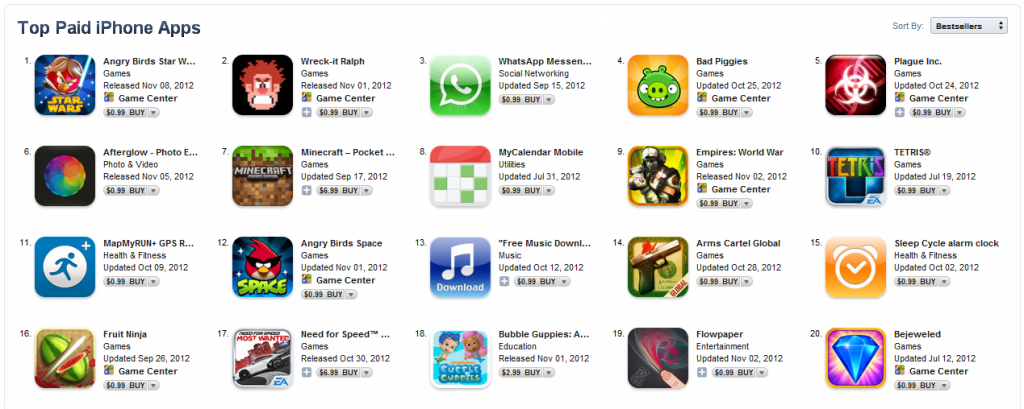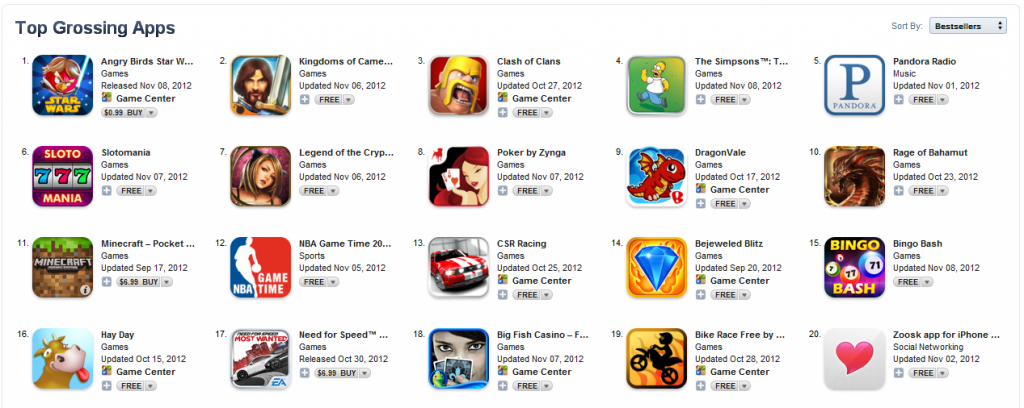We’ve all heard stories of developers making millions of dollars from apps. However not all apps make money in the same way. And in fact, there are several very popular apps out there, that don’t make any money at all. How does it all work? How much should you charge for your app?
Pay to Download: This is how most people expect app developers to make money. You create an app, set a price and then people pay that price to download the app. So how much should you charge for your app?
- Race to the bottom. Obviously the lower the price of your app is, the more units you will sell. The more units you sell, the more likely it is that your app can rank in the charts. The higher your app ranks in the charts, the more units it can sell. The more units it sells, the more money you make. See how that works? As a result, the price that most people charge for their apps is $0.99. $0.99 is also a price that results in a lot of impulse buys – it’s only $0.99 so people are willing to try out your app, since even if they don’t like it, they are only out $0.99.
- Niche Markets: There are exceptions however. If your app is in a niche market that doesn’t have many competitors, then you may find that you get the same number of downloads, whether you price it at $0.99 or $4.99 – so you may want to experiment with pricing to see which price makes you the most money.
As an example, here is a snapshot of the top selling apps (unit sales) in the US on Apple’s app store.
If you look at the pricing, you’ll notice that 16 of the top 20 best selling apps (80%) were priced at $0.99.
Free app: There are 4 ways to make money from free apps:
- Make your app free, and run ads on the bottom. Unfortunately though, unless your app has broad appeal and is used by hundreds of thousands of users, then it is hard to make significant money from this model, using traditional markets. If your app is targeted at a niche market however, you may be able to manually charge for ads.
- Create a lite version of your app that lets users try out your key features. If it’s a game for example, the free version could let you try out the first level or two. If they like your app, then you hope that they pay full price to upgrade to the paid version. This is also knows as the freemium model. You may even find that you can get away with charging a higher price for the paid version since the user is now sold on your app.
- Many apps are given away for free, in order to promote a brand, website or other product. A finance website might create a financial calculator app that is free, but that promotes their website brand. Or a car company might create a driving simulator app that is free, but that promotes theirs cars.
- In the last few years, in-app purchases have been extremely popular. They allow developers to charge users to unlock specific features and add-ons from within the app. So now an app can be free, or for a lower price, and users only have to pay for features they will use. How popular are in-app purchases? Take a look at the picture below:
Even though this is the “Top Grossing Apps” list, 17 of the top 20 apps here are free! The rest of their revenue comes from in-app purchases which provides them with even more revenue than standard paid app sales.
Which of these strategies fits best for your mobile app? Are there any additional add-ons that you can include as in-app purchases to increase your revenue further?


